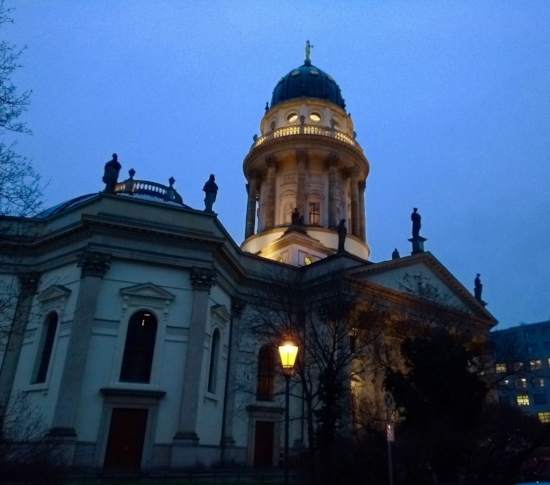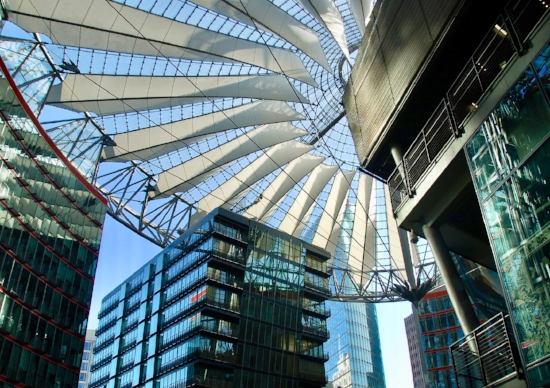Perhaps the most iconic symbol of this once-divided city, and probably the top of the list of "must see sites" for tourists, how could I make a trip to Berlin and not visit those famous columns and chariot atop? Today, I'm wandering at the Brandenburg Gate, down Under den Linden and right into the beautiful Gendarmenmarkt and ending at the Potsdamer Platz. Not hard on the feet, but full of history...
Built somewhere between 1788-1791, and the last remaining gate through which people used to enter Berlin, I think it safe to say that this neo-classical military monument is "the" symbol of peace, hope and unity in the city. Commissioned by Frederich Wilhelm II and modelled on the Propylaeum of Athens’ Acropolis, in 1806 the Quadriga (the horse-drawn chariot atop the gate) was stolen by Napoleon's soldiers (and later returned to Germany after the Emperor's defeat).
Before the wall came down in 1989, it was here that visitors could climb an observation strip and stare across into the enclosed East. It was also here that Ronnie Reagan made his famous "Mr Gorbachov, tear down that wall..." speech. Today, it's a place where people come to celebrate and where a lot of fireworks are set off, at 'Sylvester' (the German New Year's Eve).
Walking down Unter den Linden (in the direction of Alexander Platz and the TV tower) I'm taking a right turn into the what is arguably the most beautiful square in Berlin - the Gendarmenmarkt. Made up of three landmark buildings - the Französischer Dom (French cathedral), Deutscher Dom (German cathedral) and the Konzerthaus (concert hall) - keep a look out for the statue of the German poet Friedrich Schiller, in its centre.
The two churches look rather similar - the Französischer Dom is slightly older (built between 1701-05) it became home to the Huegenots, who had suffered persecution from France's Catholics and so fled to Berlin, a model of Protestant tolerance at the time.
Its competition is the Neue Kirche (colloquially known as the German Dom/New Church). Established in 1708, with its Dome added in 1785 (giving it an extra bit of charm) it was destroyed in World War II by fire, and only reopened in 1996. Today you can take guided tours relating to German Parliamentary democracy.
The area today is quite ritzy - home to fancy restaurants, chic bars and some rather modern architecture (see below).
From this beautiful square, it's only a hop, skip and a jump to the Potsdamer Platz - and as I arrive there I hardly recognise it. When I lived in Berlin, back in 1991, it was an empty space, a 'hangover' from the times of the divided city. (Incidentally, here's a map from back then, to give you an idea of how the city looked before unification...)
Pic. courtesy of Shapers of the 80s.
After Berlin was reunited, plans were put in place to rebuild the entire area. (Of course, they would take ages to get off the ground). I remember aimlessly wandering around the area, at the weekend, staring at chunks of the wall lying on the ground. (No doubt if I'd been more entrepreneurial I'd have pocketed some and kept them in my attic, to sell on eBay years later!)
Now I've returned - and to be frank, I prefer it the way it was. Glitzy and glassy, filled with shopping areas and cafes, I could be in any large city in the developed world. Call me old-fashioned, but I liked the silence, the emptiness, the dilapidated feel of the place back in the 90's. The Sony centre and exhibitions where you can 're-live' life amidst the Wall, and wander at Checkpoint Charlie (with actors now dressed up as soldiers) feel so shallow and Disneyfied to me -and sadly, I realise, that all I'm left with now are a few memories.
Nor am I a fan of the huge malls that have been erected (see above). Wandering there made me yearn for times gone by. Actually, if I were given the choice, I believe I'd like to have lived in Potsdamer Platz in the Roaring 20s (if you wanted to feel the pulse of the city and get a sense of what a melting pot it was, it was to this Platz that you'd head).
My walk is over - the Gate and the nearby square are much as I remember them, but everything else has been transformed. I feel somewhat sad and a little disconerted. It's strange to return to a city you loved, 25 years later, and find an entire neighbourhood barely recognisable. Still, as the old saying goes, "You can never go home..."
See you next time.








